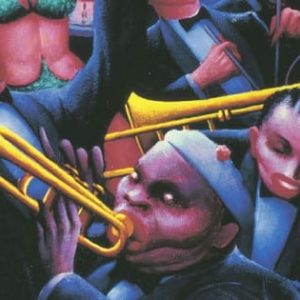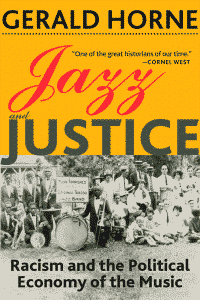Jazz and Justice: Racism and the Political Economy of the Music
456 pp, $27 pbk, ISBN 978-1-58367-785-8
By Gerald Horne
Reviewed by Timothy Brennan for Race & Class, Vol 61, Issue 3, 2020
Viewed, it would seem, from every possible angle, jazz seems to be a topic about which there is little left to say. But no one has quite seen it in the lurid, smoky light of the jazz demimonde – a world of pimps, gangsters, strung out divas, knife-wielding trumpeters, Bolshevik pianists and impresarios in white hoods. The author’s research is breathtaking. To read the book is to be barraged with anecdotes, quotations, statistical asides and mini-histories that are often no more than a paragraph long. Some of the vignettes are enduring: the animosity and racist bilge of Pope Pius XI, for example, who blasted jazz’s ‘arrhythmic howls and wild cries’. For all its abundance, however, the book is held together by a recurring theme: namely, that jazz flourished not in spite but because of the racketeers, Jim Crow partisans and white supremacists plaguing its art. In part, it is a tale of endurance; in part, of having no choice. In the end, the pain inflicted on black minds, bodies and pocketbooks that Horne wagers had given the music its authenticity. As though it were a court proceeding, Horne chronicles the sheer nastiness of being a black performer in twentieth-century United States.
It is doubtful that he entirely lives up to the ‘political economy’ he promises us in his title. His contribution is rather to give us snapshots of the personalities hounded by the exchange of cash in a seedy business. As a result, the focus frequently shifts, because this exchange takes so many dissimilar forms. He explores, for instance, the fight of black performers to unionise; the persistent underpayment or non-payment of professional musicians; the theft of black melodies, arrangements and instrumental techniques; and the absurd campaigns to claim jazz as a white invention. One of the most original aspects of the book is the glimpse it provides of the friction between American ethnic entrepreneurs (‘self-promoting blowhards and xenophobic racists’) and the artists and composers who made up black musical labour. Italian-American mob bosses and Jewish Mafiosi come in for particular abuse.
Illustrations abound of the micro-economies surrounding performance and recording. Money-making flourished in the allied businesses for which jazz was the fertile soil – gambling, whoring, protection schemes and the legal dispossession perfected by record labels operating as forms of indenture. The big names in jazz from Jelly Roll Morton to Kid Ory and Clark Terry had to work as bellboys, carpenters, coal-cart drivers and stevedores to stay afloat when club owners refused to pay them. Performers at the Cotton Club were not allowed to quit. It was a form of ‘neo-slavery’. Nightclub potentates became America’s first true mass market drug dealers, importing heroin and opium, and getting their performers hooked to keep them in line.
This sordid world ‘put the sin in syncopation’, as Horne puts it, but it also called forth a vigorous response. One of the most unusual slants of the book lies in Horne’s observation that between the 1920s and the 1960s, jazz signified as communist. Being black and being ‘red’ became hopelessly fused, partly as a shared paranoia, partly because of the very real connections between them. Not since Frank Kofsky’s Black Nationalism and the Revolution in Music (1970), which explores the cold war dimensions of bebop, have these connections been so interestingly drawn. Jazz, it turns out, was filled with politically progressive men and women, although not always (Lionel Hampton was a rightwing Republican who exploited black musical labour with the best of them). American communism, moreover, played the honourable role of promoting jazz in hard times, and working for musicians to get a decent wage. Other responses to the onslaught were more personal. Miles Davis, Cab Calloway and dozens of other performers were rough-edged survivors in a world of ruffians, forced to carry knives and pack revolvers in order to defend themselves after the bus dropped them off for gigs in rural Texas. The grandest response was the Great Migration itself, the ‘mass flight from Dixie’ to Chicago, Harlem, Paris and Moscow.
Horne’s book is not without flaws. For all its data, it never finds a narrative voice. One almost senses him at his desk, struggling to find a place he might insert all the information. The reading for that reason is somewhat choppy in places and plagued by repetition. The evocative titles of the chapters (among them, ‘Lullabye of Birdland’, ‘Haitian Fight Song’) do not especially fit their contents, since the themes (outlined above) are really the same throughout, the only distinction being the march of chronology.
The other problem is that, like many US jazz scholars, he more or less ignores its Latin origins. Too much is known today to keep maintaining that ‘New Orleans has a justifiable claim to being the birthplace of the music known as jazz’. The city was, for one thing, more Caribbean than US-American throughout the eighteenth, nineteenth and early twentieth centuries. The contradanzas, claves and sons of the Spanish Caribbean form the substrate of jazz orchestration and rhythm, and the take-off of American jazz at the turn of the century has everything to do with the US soldiers (among them, W. C. Handy) stationed in Puerto Rico and Cuba during the Spanish-American war. But that does not mean American jazz was not its own thing, or that it was not uniquely inventive (particularly in the form of bebop, whose treatment here by Horne is one of the book’s strengths). More than anything, we learn what it was like to be ‘black and blue’ in an America whose racism was, and is, operatic – a hysteria for which this music sought a cure. That picture Horne paints memorably.
—Timothy Brennan
University of Minnesota
Copyright, Race & Class. Reprinted with permission


Comments are closed.